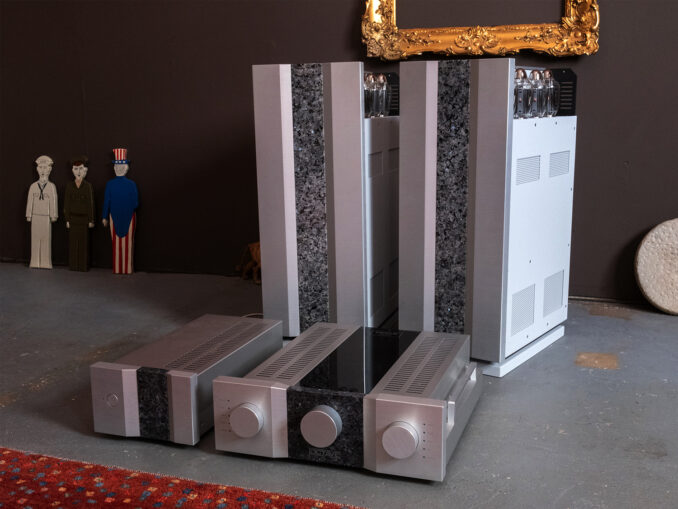
Power and grace.
The Octave Jubilee preamplifier and Jubilee Mono ULTIMATE monoblock amplifiers sit at the top of Octave’s complete line of amplification products. In brief, Octave is based in Karlsbad, Germany and the company’s history dates back to 1968 when Karl Heinz Hofmann founded the transformer winding factory Hofmann. Andreas Hofmann took over the Hofmann company from his father in 2000, giving it its new name—OCTAVE Audio—with a focus on the tube-based electronics he’d been designing and building since the 1970s using, as you might expect, all in-house designed and manufactured transformers. The first Jubilee preamplifier was released in 1998 in honor of the company’s then 30th anniversary.
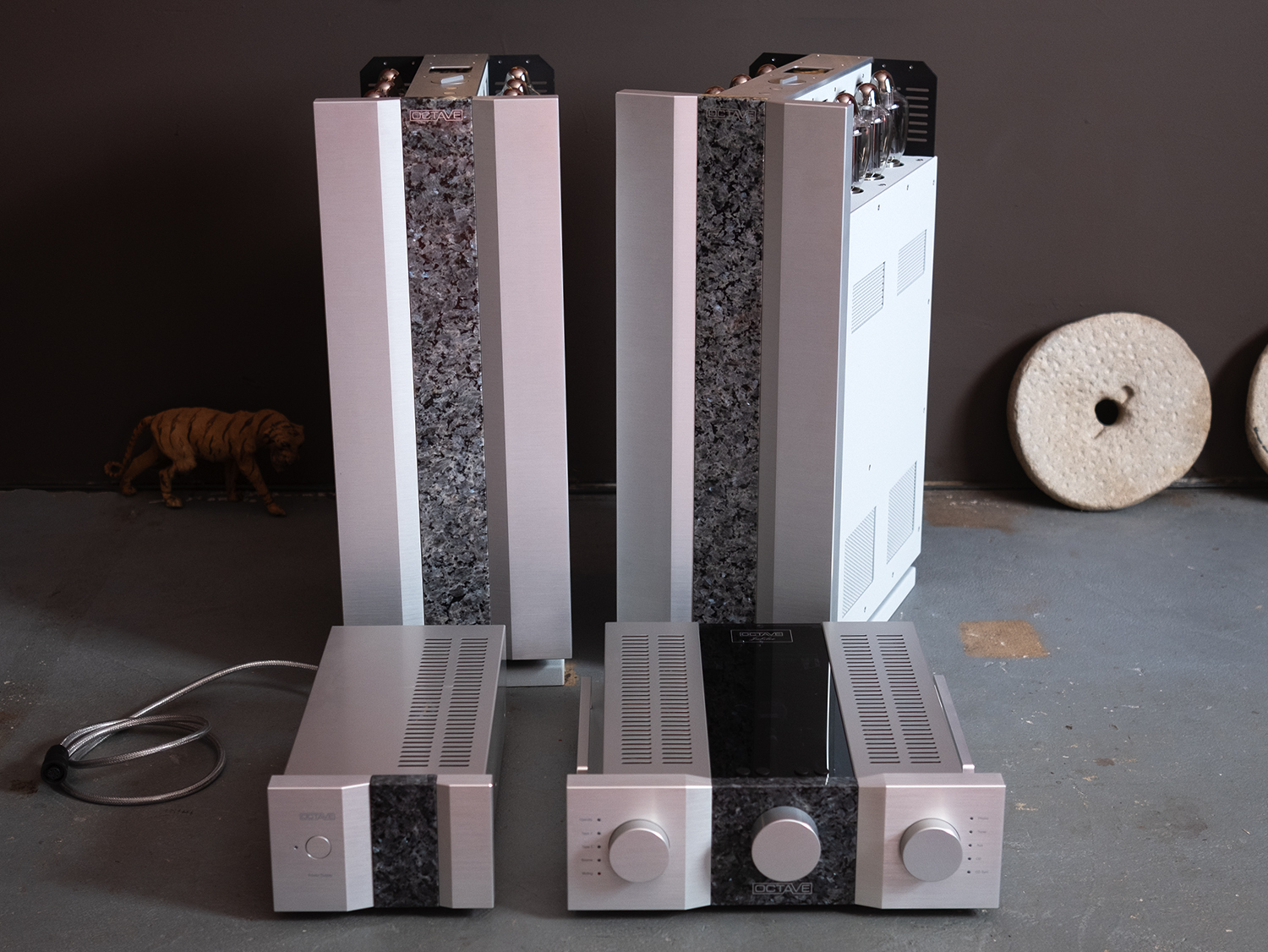
The Jubilee stack arrived in Barn at the end of April and they’ve been living on the Barn’s A-Side paired with the recently reviewed YG Sonja 3.3 loudspeakers (review), the recently arrived Ø Audio Verdande (more info), and the Barn resident DeVore O/96 (review). Three different kinds of speakers with the Sonja 3.3 representing the most difficult load presented to the Mono Ultimate with their 88dB sensitivity and 4 Ohm average impedance that dips down to 2.8 Ohms (minimum) according to YG.

I want to begin with the YGs because they tell us the most interesting story about the Octave Jubilee stack. During the Sonja 3.3’s 4-month+ Barn stay, they got to play with a number of very good to great amplification partners including the Soulution 331 integrated (review), Constellation Inspiration Integrated 1.0 (review), the Bel Canto Black ACI 600 integrated (review), the stunning JMF Audio HQS 6002 Amplifier and PRS 1.5 Preamplifier combo (review), a brief run with the recently arrived Audia Flight Strumento Series N°1 evo Stereo Preamplifier & N°8 Monoblock Power Amplifiers (more info), and of course the Octave Jubilee stack. And I can say with certainty that the Octave stack were my favorites with the Sonja 3.3 because they took hold of their potential performance most completely from bottom to top with effortless, rich, and stunning authority.

While the JMF Audio stack was my favorite during the Sonja 3.3’s review period, the big Octave Jubilee Ultimate monoblocks quickly announced themselves as being an even more appropriate partner as they lit up the big YG’s with superb control making even low-level listening full, rich, and startling. On paper, the Octave and JMF amplifiers offer roughly the same output power, 400W and 440W into 4 Ohms respectively, but the Octave monoblock’s extra oomph made the Sonja 3.3 sing more fully. As I mentioned in the YG review, I imagine the more powerful JMF monoblocks would make for a better Sonja 3.3. mate.

I’ve reviewed two other Octave amplifiers—the 8W (RMS) V 16 Single Ended Integrated/Headphone Amplifier (review) and the 50W V 70 Class A Integrated Amplifier (review).
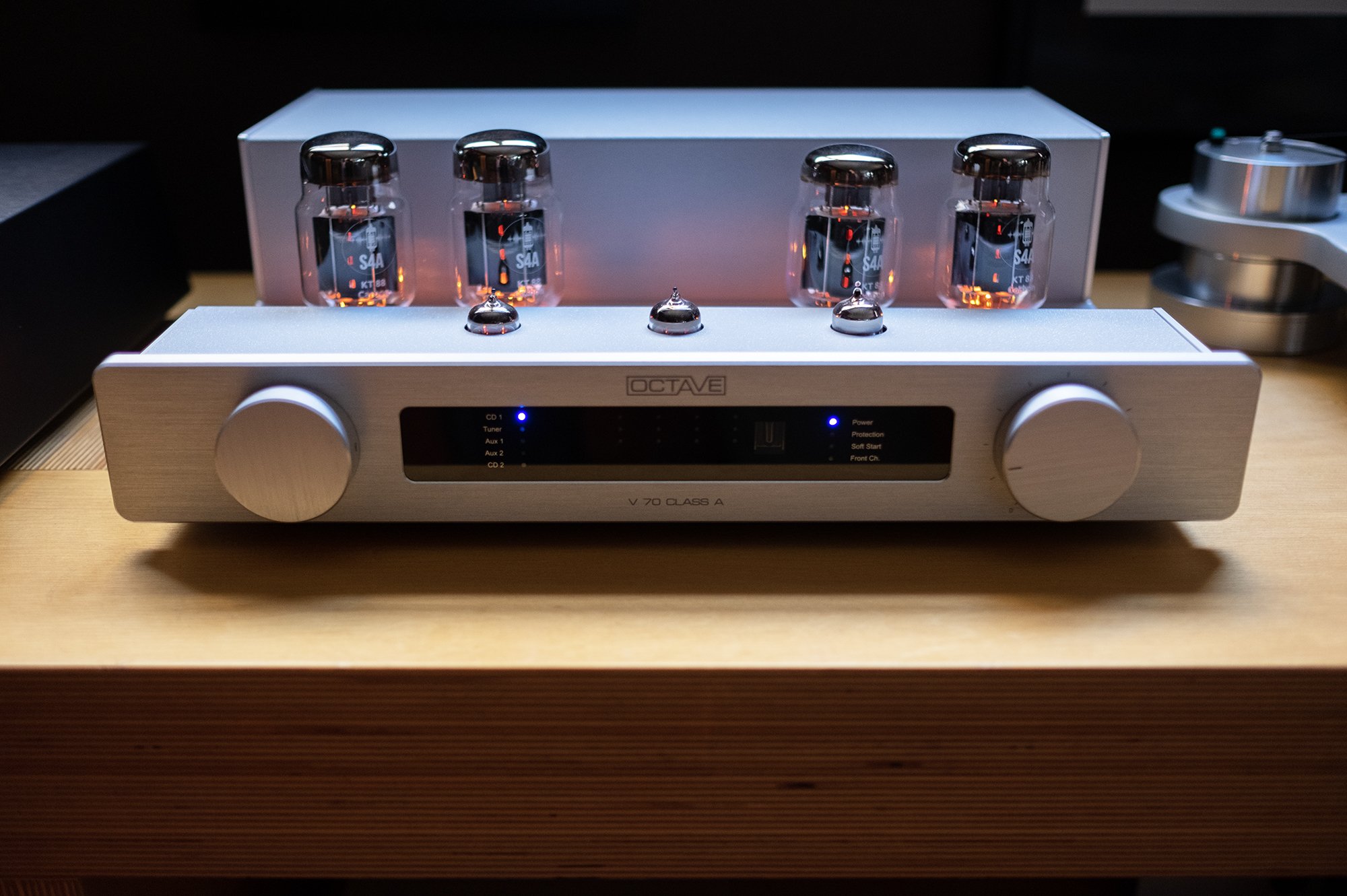
Small, medium, and large in terms of output power with the Jubilee Ultimate filling that last spot yet they all share some commonalities I would describe as clean, clear, delicate, rich, and powerful. Yes, even the 8 Watt V 16, which is the amp that quote is referring to, defy the silly cliche of expecting dark, romantic, and mushy sound from a tube amp.

While not sensible pairings considering the price discrepancies, the DeVore O/96 and Ø Audio Verdande nonetheless worked very nicely with the Octave Jubilee stack and perhaps the most notable quality here, with these high(er) efficiency speakers is the Octave gear’s near dead silent running with no audible self-noise to be found even with ear kissing driver closeness.

And the same qualities heard through the big Sonja 3.3 were also on display with the DeVore and the Ø Audio, namely effortless control, among the best bass I’ve heard from the O/96, the Audia Flight FLS 10 integrated (review) was also outstanding in this regard, coupled with a just-right richness and dynamic rightness that are qualities I’ve heard from every Octave amp I’ve reviewed. Seamless effortless pure power.

The Jubilee Preamplifier is Octave’s flagship, a two-chassis design with an outboard power supply and featuring a two-stage hybrid design with 4x ECC82 vacuum tubes in the first stage while “the high current requirements are satisfied by an output impedance converter implemented with semiconductors. The unique combination of tubes and transistors allows the Jubilee to do without overall negative feedback and thus deliver the undeniable sonic benefits of a zero feedback design.”
From Octave:
The low impedance output is yet another feature designed to enhance the sound quality and versatility of the Jubilee preamplifier. Only a semiconductor-based output stage is able to cope with long cable runs and integrate perfectly with low impedance power amplifiers. It would be impossible to implement such an uncritical output using tubes alone without sacrificing accuracy inthe low bass and extreme high frequencies.”

The preamp proper’s front panel is very straight forward with three large and satisfying to use knobs for Mode Selection (Source, Tape, Mute), Volume Control, and Input Selection.

The Jubilee Pre’s business end is where you’ll find 6x RCA and 2x XLR inputs (optional bypass function for input tape 2) and 2x RCA, 2x XLR, and 2x Tape Record (RCA) outputs. Three toggle switches allow for selecting between the RCA and XLR inputs as well as Ground Lift switch that disconnects the ground for the XLR inputs. On the far left is the infrared receiver connector for the included remote and on the far right is the connector for the outboard power supply.

Moving between the Sonja 3.3 and O/96 also made good use of the Jubilee Preamplifier’s Gain Selector option, moving from Low for the high(er) sensitivity O/96 and High for the low(er) sensitivity Sonja 3.3 resulting in a useful range for the Jubilee pre’s silky smooth volume control or included chunk of aluminum remote with both speakers.

The Octave Jubilee Ultimate Monoblocks sport 8x KT 170s per side that put out 440W into 4 ohms (and heat) and weigh about 170 lbs a piece which explains why they never left the A-Side once settled in. Hidden inside are 3 driver tubes including a pair of ECC82/12AU7 and a single ECC99.

Biasing those power tubes is a manual but simple process accomplished by using the Bias Control dial to step through each tube for adjustment while using the rear mounted ‘Bias Regulator’ set screws to dial-in each tube to 950 – 1050 on the display. Easy peasy but if you’d like to into more details, head on over to the Jubilee Ultimate manual.

Here’s Octave on what’s new with the Jubilee Ultimate as compared to the Jubilee Mono which were originally released in 2000:
What’s new?
KT 170 output tubes
Oversized ultra broadband output transformer
Speaker windings using multi-wire technology to minimize the skin effect
Further developed driver stage with changed tube layout
Mains transformer unit with 3 mains transformers
New power supply electrolytics with higher current delivery capability
BIAS display and setting with significantly higher long-term precision
Resonance-optimized base construction (8 mm aluminum, 2 mm steel, 50 mm X-MDF)

Around back reside the BIAS Regulator set screws for each output tube marked V1 – V8, a single set of RCA and XLR inputs, a switch for selecting between them, another switch to run the amps in ECO Mode “that automatically switches off the tube section of the device after approx. 7-10 minutes during breaks in operation without a music signal”, a pair of binding posts, a 20 Amp IEC inlet, and a Remote Control input that allows for control of the Monos from an attached Octave preamp.

It’s worth noting that I got in a complete set of cables and power products from AudioQuest including 2x FireBird High Current power cables to accommodate the Jubilee Ultimate’s 20 Amp IEC inlets, a pair of FireBird Bi-Wire speaker cables for the Sonja 3.3, a long run of Firebird XLRs, and a Niagara 7000 power conditioner to plug the amps into. When system building it’s important to consider the entire system and anyone who claims things like cables and power do not make a difference have let dogma clog their ears.
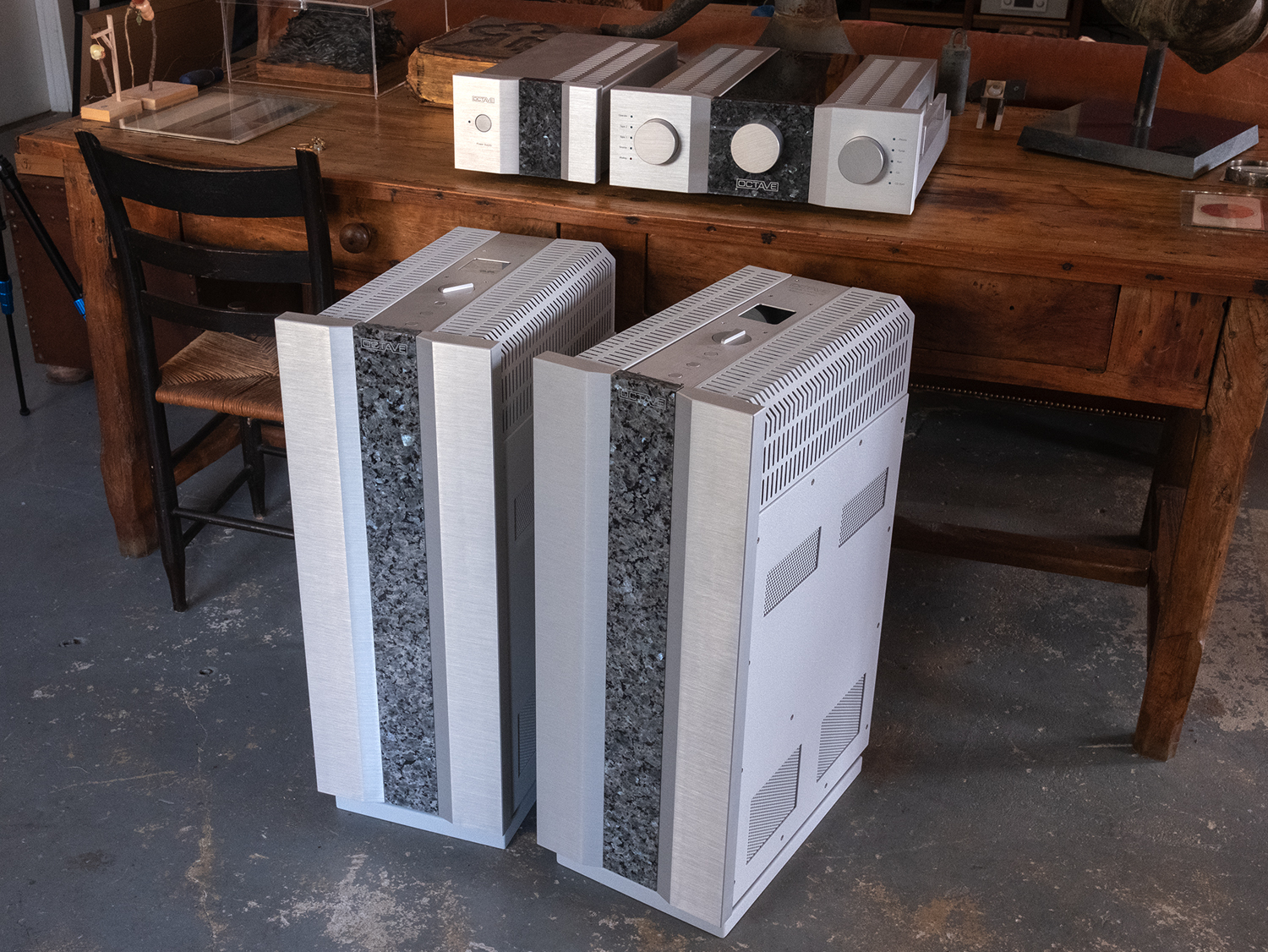
The Jubilee Preamp and Mono amps come in black or silver with a number of stone and wood options running down their centers. Sleek. My favorite combo is black aluminum bits with the Makassar Burl centers, a combination I’ve seen at shows and you can see below. The review pair seem well suited for a more modern and minimal decor than the Barn’s eclectic curiosity shop vibe. Overall build quality is excellent and the Jubilee Ultimate mono amps look the part of tall towers of power.
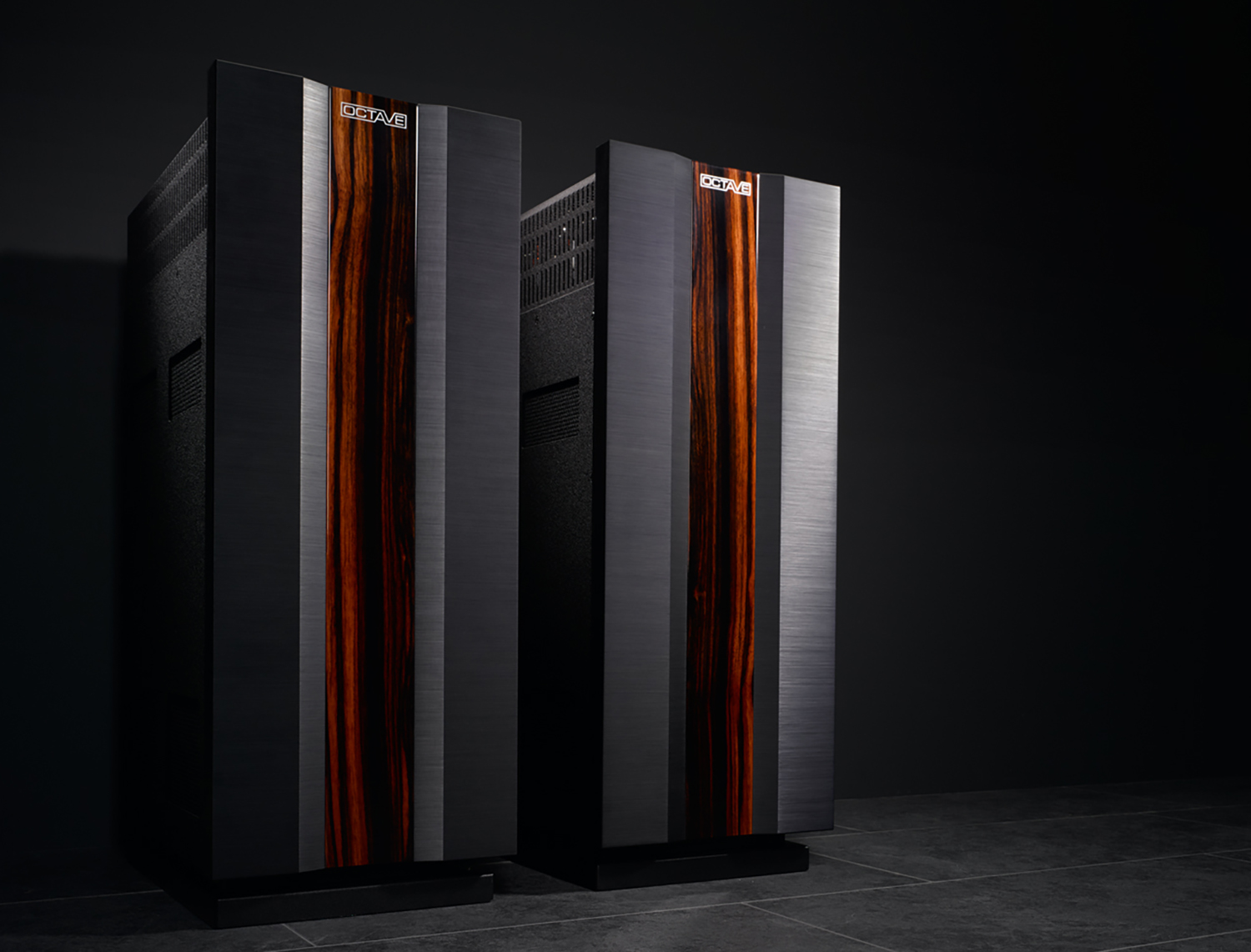
Here’s a sentence from Octave Audio’s About page that tickles my fancy:
Music is not just about precise highs, mids and bass, but about the fun, the emotion in the music that makes the soul vibrate. We claim that Octave amplifiers transport these vibrations and that listening to music with Octave is an unforgettable experience.
An emotional connection to music is something I crave, something I strive for in my own system, and I love the idea of hifi making my soul vibrate with musical goodness. If you prefer a more scientific approach, here’s something from McGill Study Suggests We Don’t Just Listen to Music, We Become It:
“This theory suggests that music is powerful not just because we hear it, but because our brains and bodies become it,” said Palmer, Professor in the Department of Psychology at McGill and Director of the Sequence Production Lab.
I’ll even through in some philosophy for those so inclined:
“Musical training is a more potent instrument than any other, because rhythm and harmony find their way into the inward places of the soul.” — Plato, The Republic (c. 375 BC)

One outstanding trait found in the Octave stack is the ability to deliver effortless, silent power even into a difficult load combined with the lightest of touches, a delicacy that reaches deep down into macro-level nuance while always exhibiting what feels like a natural timbral richness which is to say not overly ripe or lean. These combined strengths are a rarity in my experience, especially so at the level of performance exhibited by the Octave Jubillee stack where listening becomes truly magical and endlessly delightful well beyond the confines of hifi concerns.
A relatively recently-found favorite finds M. Ward with a full backing band on 2006’s Post-War with additional vocal help from Neko Case and My Morning Jacket’s Jim James. Laid back intimate easy listening, and hippy-ish in the best way, Post-War feels like you’ve found yourself in a comfy home filled with friends making music and the Octave stack painted this picture with a naturalism in timbre, detail, and place through the Ø Audio Verdande that put me in a seat seemingly strategically placed amid the mix. I’m a sucker for the sounds of acoustic guitar when it sounds out like the real thing and I was suckered deep into this folk-inspired communal-feeling music as if I was part of the band.

The Octave stack, with help from the Barn resident Grimm MU1 (review)/totaldac d1-unity (review) combo with equally important help from AudioQuest Thunderbird Zero speaker cables and a long run of FireBird XLR cables to bring the signal from the Jubilee preamp sitting on my Box Furniture rack over to the Jubilee Ultimates standing tall next to the speakers, excelled at recreating the scale, feel, and physicality of the place of a recording whether lounge room intimate or concert hall grand. Bravo! (see full Barn and system details)
On grander music, the Octave/YG combo delivered a cinematic experience of drive-in movie scale in 3D as seen from a child’s eyes where things are still capable of being magical and real at the same time. Think wonder.
From the liner notes of Bernard Parmegiani’s Complete Works 10: Lac Noir – La Serpente (1990-92):
“At the end of May 1992, in Provence, in his summer studio not far from the Montagne Sainte-Victoire, Bernard Parmegiani played me the first musical moments he had worked on from the sounds he and Christian Zanési had collected in Negreni in October 1990. A few days after this listening session, on 4th June, I wrote him a letter. I didn’t mean to take control of what was to become the ninth movement of his composition, but to share with him some of the resonances I had heard in what he had composed, which mingled with my dreams and memories of the Transylvanian snake-woman, and outlined possible concordances with the other pieces underway for Lac Noir.”
This is electro-acoustic music composed and comprised of field recordings made by Parmegiani in Transylvania transformed in the studio into an otherworldly weird-scape that feels convincingly creepy. Menacing, even, as it borders on what I imagine hallucinatory madness sounds like moving from gypsy style folk to deep, dark, drone, and well out into the nether regions where snake-women roam free. Through the big YG’s, the Octave stack blew this madness up to larger than life scale, a massive deep, dense, and wonder-filled eerie place that made the occasional Barn snake feel like a welcome guest. Snakes, I will share, creep me out. All of the electronic blips, burbles, and shooting stars of sounds mixed with keyboard squalls and distant bird-like screeches were reproduced with perfect scale and Barn-filling presence that drove home the reason why perfectly controlled big speakers have their own special appeal. Namely, the ability to make big music sound and feel convincingly real. And big.
And gnarly music sounded gnarly. Caspar Brötzmann Massaker’s It’s a Love Song co-released by Corbett vs Dempsey and Exile on Mainstream back in June, is an all-out sonic assault for electric guitar, bass, and drums. Recorded live in Berlin and Vienna in January of this year, Casper Brötzmann turns his six string into a more dangerous and foreboding version of Hendrix at Woodstock. Primal, overdriven, cavernous guitar crush opens both versions of “All This Violence” and you really want, need?, power and force without the system buckling under the pressure and the Octave stack seemed perfectly non-plussed by Casper & Co’s manic quaking explosions.
Brötzmann plays with feedback, harmonics, and overtones that contain, perhaps contrary to the idea of it, delicate moments amid earthquake force and at Barn-rattling levels highlighted the importance of the Jubilee stack’s near silent running and complete control of the big YG’s that do full range and then some. Woof! I also let a few tracks from It’s a Love Song rip on the Ø Audio Verdande and that combo also had real bite, growl, and Barn-rattling intensity. Think badass-ness.

The Octave Jubilee stack costs more than anything I’ve reviewed by a wide margin so I cannot offer any sensible comparisons. What I can share is that I’ve never heard amplification that combines the Jubilee’s strengths while also sounding right at home with both low and high sensitivity speakers.
Meg Duffy, founder of folk-rock band Hand Habits, and Gregory Uhlmann who plays guitar in a number of touring bands including Perfume Genius came together on guitar for the aptly-named Doubles, released in 2023 on Ordinal Records.
From the liner notes:
Blurring the limits between speed and slowness, Meg Duffy (guitar) and Greg Uhlmann (guitar) communicate in velocities, underwriting each other’s peaks and flurries as they ache toward a mutual horizon. These one-take improvisations, recorded in Uhlmann’s brothers’ house on a borrowed tape recorder, unfold like a game of truth or dare. Their constant motif is an unceasing return, a steady heartbeat they mutually commit to, knowing when one wanders off, the other will either follow or call them home. Here, flushness overrides order, each note saunters by like initials etched into tree bark: a devotion both passing and eternal.
This is delicate music focused on timbre, touch, and interplay where the union and separation between players feels like an old conversation among intimates spoken in some ancient language. As you might imagine, every last slice of sound adds to meaning and here the DeVore O/96 acted as interpreter with the Jubilee stack providing the beating heart. This pairing highlighted the Jubilee’s stunning way with delicacy, a lightness of touch, precision, and speed that perfectly served the DeVores and this music, creating a sound and experience in Barn that brought me within a breath of this lovely music-making. The sound image had a perfect mix of air, silence, space, and guitar that felt like real music energy in solid form, a kind of crazy presence that reaches well past our ears and brains, digging deeper into primal places where music speaks to things well beyond the present. The fact that this same Jubilee stack conjured the best performance from the big YG Sonja 3.3 is a very rare set of skills.
Expectations are a funny thing. When sitting in front of big speakers and big amps it’s hard not to focus on big music and big sound. But this is where time comes in handy and I spent 4+ months with the big YGs and more than 2 months with the Jubilee stack which let me get beyond big and dig deep into favorite tracks of all shapes and sizes that illustrated with tactile goodness how capable the Octave Jubilee gear is at music-making to a degree that transcended expectations. Of course I reveled in the big and bombasitc, who wouldn’t when given this kind of rare opportunity, but of equal importance I also danced with the delicate and fawned over quiet storms.

I imagine we all want it all when it comes to spending our hard-earned money on hifi. Beauty, power, delicacy, richness, and agility adding up to the ability to transform recorded music into something special, something magical that fully captures our attention deep down inside. The Octave Jubilee Preamplifier and Mono ULTIMATE Monoblocks brought just this kind of seamless transformative experience through three very different pair of speakers, bringing out the best in each. If you’re looking for it all, the Octave Jubilee stack has as much of it as I’ve had the pleasure of experiencing in Barn.
Octave Audio Jubilee Preamplifier
Price: $40,000
Octave Audio Jubilee Mono ULTIMATE Monoblock Amplifiers
Price: $135,000/pair
Company Website: Octave Audio
US Distributor Website: Dynaudio North America
Jubilee Preamplifier Specifications
Options:HT Bypass, Stepped Attenuator
Design: Silver or Black; Front middle sections: Slate, Granite. On request: Jungle Stone, Birch, Walnut, Makassar Burl
Tube configuration: 4 x ECC 82
Inputs: 6 x RCA, 2 x XLR (optional bypass function for input tape 2)
Outputs: 2 x RCA, 2 x XLR, 2 x Tape Record (RCA)
Dimensions: Preamplifier / Power Supply 43.5 x 15.2 x 48.0 cm / 22.0 x 15.2 x 48.0 cm (W x H x D)
Weight: Preamplifier / Power Supply 17.2 kg / 11.5 kg
RCA Gain factor: 10 dB / 17.5 dB (Gain Low / High)
XLR Gain factor:16 dB / 23.5 dB (Gain Low / High)
Frequency range: 3 Hz – 100 kHz 1.5 dB
Harmonic distortion: 0.1% at 3 V / 7.5 kOhm
Signal-to-noise ratio: 90 dB (Gain High) / 98 dB (Gain Low)
Jubilee Mono ULTIMATE Monoblock Amplifier Specifications
Option: Remote power on
Design: Silver or Black, middle section optionally in stone or wood
Tube configuration: 8 x KT 170
Inputs: 1 x RCA, 1 x XLR
Outputs: Speaker output suitable for banana plugs and cable lugs
Dimensions: 280 x 750 x 484 mm (W x H x D)
Weight: 78.0 kg
Output power: 440 W on 4 ohms
Frequency range: 10 Hz – 80 kHz
Harmonic distortion: < 0.1 % at 10 W on 4 ohms
Signal-to-noise ratio: -103 dB
Gain: +28 dB Cinch
Input sensitivity: 1.5 V

